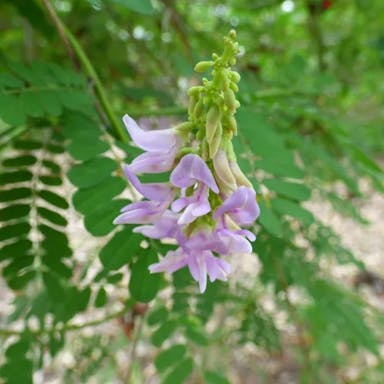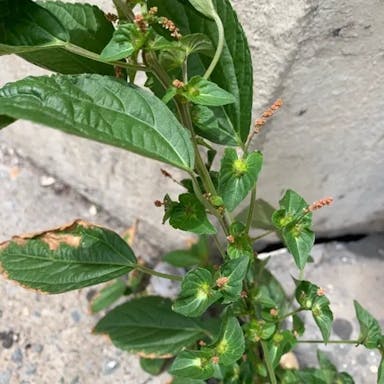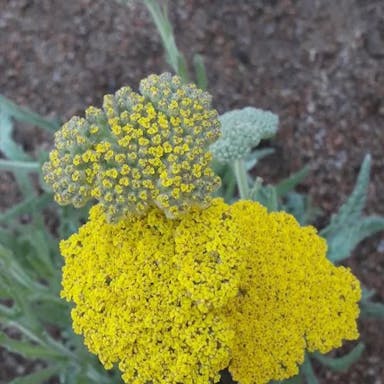For the plant Inrygertjie, watering frequency should be every 7-10 days during the growing season. Ensure the soil is evenly moist but not waterlogged, allowing the top 1-2 inches to dry out between waterings. During the dormant season, reduce watering to every 2-3 weeks to prevent root rot. Monitor soil humidity by inserting a finger into the soil; if it feels dry, it's time to water. Water in the morning to allow excess moisture to evaporate during the day, preventing fungal diseases. Adjust watering based on environmental conditions such as temperature and humidity.
Inrygertjie
- Scientific name
- Crassula rupestris
Basic Information
- Crassulaceae Family Crassula Genus Inrygertjie Species
- Crassulaceae > Crassula > Crassula rupestris
- 83%
- The Completeness of This Encyclopedia
Please help us complete the encyclopedia, Terrarium is a encyclopedia service to be completed with everyone in the world. Currently, this page is 83% complete. For more information on how to contribute, please click here.
- Forb/herb
- Perennial
- Subshrub
- Height
- 30cm ~
- Flower Color
- Leaf Color
- Anthesis
- spring
- Sunlight Exposure
Full Sun Long hours of sunlight from morning to afternoon Partial Shade A location in the shade of a tree or where either the morning or afternoon is shaded Full Shade A place where there is no direct sunlight
- Full Sun
- Hardiness Zones
This is an indicator to know to which zone each plant can winter. Knowing the zone of each plant gives you an idea of the cold temperature resistance when grown in the ground without a roof. 2: -42.7 to -40.0 3: -39.9 to -34.4 4: -34.3 to -28.9 5: -28.8 to -23.3 6: -23.2 to -17.8 7: -17.7 to -12.2 8: -12.1 to -6.7 9: -6.6 to -1.1 10: -1.0 to 4.4 11: 4.5 to 10.0
- 9
- Cold resistance
- Fair
- Heat resistance
- Good
- Habitat of origin
- South Africa
- Growth Rate
- Normal
What is Inrygertjie (Crassula rupestris)?
What is Inrygertjie (Crassula rupestris)
Flower meaning
Inrygertjie thrives in full sun exposure, requiring at least 6 hours of direct sunlight per day. It exhibits excellent heat tolerance, making it suitable for hot climates. Cold tolerance is limited, and it should be protected from frost. During winter, it is advisable to bring Inrygertjie indoors or provide adequate insulation. Optimum temperature ranges between 65-75°F (18-24°C). Over summer, ensure consistent watering and avoid waterlogging. In winter, reduce watering frequency to prevent root rot. Place Inrygertjie in well-draining soil and avoid overcrowding to promote air circulation. It is essential to monitor sunlight exposure to maintain its health and vibrancy.
Calendar of Inrygertjie (Crassula rupestris)
Calendar
Inrygertjie, also known as Crassula rupestris, is a succulent plant native to South Africa. It belongs to the Crassulaceae family and is characterized by its compact, branching stems and thick, fleshy leaves. The leaves are triangular in shape and have a gray-green color with red margins, giving the plant a striking appearance. Crassula rupestris produces small, star-shaped flowers that are white or pale pink in color. These flowers typically bloom in clusters at the ends of the stems, adding to the plant's ornamental value. The plant is relatively easy to grow and is well-suited for cultivation in containers or rock gardens. It thrives in well-draining soil and requires minimal water, making it a low-maintenance choice for gardeners. There are several varieties of Crassula rupestris available, each with its own unique characteristics and growth habits. The plant may also produce small, inconspicuous fruits after flowering, although these are not a prominent feature of the plant.
How to grow Inrygertjie (Crassula rupestris)
Watering
Inrygertjie thrives in well-draining soil with a pH level between 6.0 and 7.0. It requires a balanced fertilizer with equal parts of nitrogen, phosphorus, and potassium. Fertilizer should be applied in early spring before new growth begins, and again in mid-summer to support flowering. Apply fertilizer at a rate of 1 tablespoon per square foot of soil. Avoid over-fertilizing as it can lead to nutrient imbalances. Regularly check the soil quality to ensure it remains loose and fertile. Amend the soil with organic matter if necessary to improve its structure.
Soil and Fertilizer
Inrygertjie is best potted for optimal growth and maintenance. To pot Inrygertjie, choose a well-draining potting mix and a container with drainage holes. Place the plant in the center of the pot, ensuring the roots are spread out. Fill the remaining space with soil, leaving a gap between the soil and the rim of the pot for watering. Water the plant thoroughly after potting and place it in a location with indirect sunlight. Repot Inrygertjie every 1-2 years or when the roots outgrow the pot. When repotting, gently loosen the roots and place the plant in a slightly larger pot with fresh soil. Mist Inrygertjie occasionally to maintain humidity levels.
Sunlight and Place
Inrygertjie pruning is essential to maintain plant health, promote growth, and enhance flowering. Pruning should be done in late winter or early spring before new growth appears. Remove dead, damaged, or diseased branches first, followed by shaping cuts to maintain the desired form. Cut back to a lateral branch or bud at a slight angle, just above the node. After pruning, clean tools with a disinfectant to prevent the spread of diseases. Dispose of pruned material properly to avoid contamination. Regular pruning will help Inrygertjie thrive and remain vigorous.
Advanced Information of Inrygertjie (Crassula rupestris)
Pruning
Inrygertjie can be propagated through seeds, division, and cuttings. Seeds are sown in well-draining soil, kept moist, and placed in a warm, sunny location. Division involves separating the plant into smaller sections with roots attached, which are then replanted. Cuttings are taken from healthy stems, dipped in rooting hormone, and placed in a growing medium. Leaf cuttings can also be used by taking a healthy leaf, placing it in a growing medium, and keeping it moist. To ensure successful propagation, it is recommended to use a combination of methods to increase the chances of success.
Planting and Harvest
Inrygertjie is susceptible to aphids, spider mites, and powdery mildew. Aphids can cause yellowing and curling of leaves, while spider mites can create webbing and stippling on the foliage. Powdery mildew appears as a white powdery substance on the leaves, inhibiting photosynthesis. To prevent aphids and spider mites, regular inspection and insecticidal soap application can be effective. For powdery mildew, ensuring proper air circulation and avoiding overhead watering can help reduce the risk.
Propagation
Inrygertjie in the United States typically blooms in late spring to early summer. The flowers are at their best during the month of June. Blooming occurs once a year, lasting for about 2-3 weeks. To extend the blooming period, ensure the plant receives adequate sunlight, water, and nutrients. Deadheading spent flowers can also promote continuous blooming. Maintaining consistent soil moisture and avoiding extreme temperature fluctuations can help prolong the flowering season. Pruning faded blooms can redirect the plant's energy towards producing new flowers. Additionally, fertilizing the plant with a balanced fertilizer can support healthy growth and prolonged blooming.
Pests and Diseases
Inrygertjie has two main varieties: Variety A and Variety B. Variety A is characterized by its compact growth habit and pink flowers, making it ideal for small spaces. On the other hand, Variety B is known for its trailing stems and white flowers, suitable for hanging baskets or cascading planters. When selecting seeds, choose plump, firm ones without signs of damage. For seedlings, opt for those with healthy green leaves and sturdy stems. Ensure the roots are well-developed and not root-bound. It is essential to select varieties based on your specific preferences and the growing conditions available to you.
Habitat of Inrygertjie (Crassula rupestris)
Habitat
Toxicity of Inrygertjie (Crassula rupestris)
Health Benefits
- edible
- Inedible
- Toxic
- No toxicity
NO DATA
Toxic for dogs and cats
NO DATA












